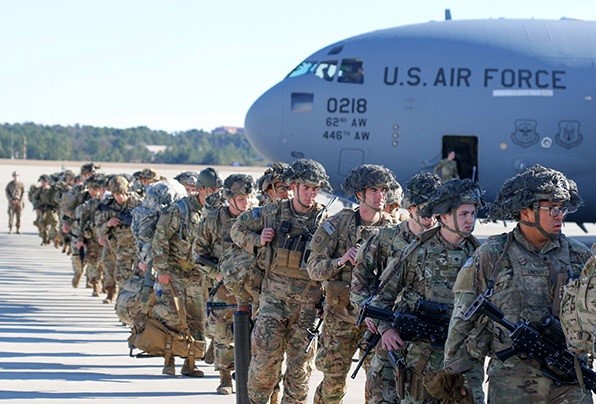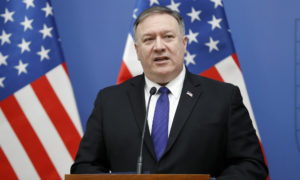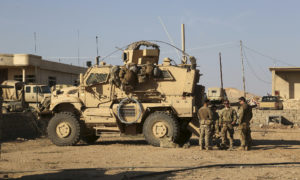
Trump announced to send 3,000 soldiers to Middle East amidst rising tensions with Iran
A day after the United States (U.S.) forces killed the Iranian Major General in the Islamic Revolutionary Guard Corps (IRGC) and Commander of its Quds Force – Qasem Soleimani, the U.S. has announced to send 3,000 additional troops to the Middle East from the 82nd Airborne Division.
The decision to send troops to Middle East is a precautionary measure in the wake of rising tensions between Islamic Republic of Iran and the U.S., especially when Iran has vowed to take revenge.
Soleimani was killed in an air strike, carried out by a drone, at Baghdad International Airport in Iraq on Friday, January 3, 2020. In addition, the Deputy Head of the Iran-backed Iraqi Popular Mobilization Forces (PMF) – Abu Mahdi al-Muhandis was also killed.
Prior to this, U.S. had sent 750 troops to Kuwait after protesters stormed the U.S. Embassy compound in Iraq. Since May 2019, U.S. has sent a total of more than 14,000 troops across Middle East, citing concerns of possible attacks from Iran.
Addressing a Press Conference from his Mar-a-Lago resort, Trump said, “The United States military executed a flawless precision strike that killed the number one terrorist anywhere in the world, Qassem Soleimani.”
He further added, “Soleimani was plotting imminent and sinister attacks on American diplomats and military personnel but we caught him in the act and terminated him.”
In a series of tweets, Trump mentioned that Soleimani was involved in killing of hundreds of Americans and that he ordered Soleimani’s killing to stop a war.
He tweeted, “General Qassem Soleimani has killed or badly wounded thousands of Americans over an extended period of time and was plotting to kill many more…but got caught! He was directly and indirectly responsible for the death of millions of people, including the recent large number….”
General Qassem Soleimani has killed or badly wounded thousands of Americans over an extended period of time, and was plotting to kill many more…but got caught! He was directly and indirectly responsible for the death of millions of people, including the recent large number….
— Donald J. Trump (@realDonaldTrump) January 3, 2020
“… of PROTESTERS killed in Iran itself. While Iran will never be able to properly admit it, Soleimani was both hated and feared within the country. They are not nearly as saddened as the leaders will let the outside world believe. He should have been taken out many years ago,” read the 2nd tweet.
….of PROTESTERS killed in Iran itself. While Iran will never be able to properly admit it, Soleimani was both hated and feared within the country. They are not nearly as saddened as the leaders will let the outside world believe. He should have been taken out many years ago!
— Donald J. Trump (@realDonaldTrump) January 3, 2020
The U.S. has also urged its citizens in Iraq to leave the country immediately for their safety.
The U.S. Secretary of State – Mike Pompeo had called world leaders to explain to them the situation and defend Trump’s decision of killing Soleimani. Pompeo spoke to his counterparts in Afghanistan, the United Kingdom (U.K.), China, France, Germany and Pakistan. During his talks, he also mentioned that U.S. is open to de-escalation of tensions with Iran.
In a letter to the United Nations (U.N.), Iran described the attack as state terrorism and an unlawful criminal act. Iran’s Ambassador to the U.N. – Majid Takht Ravanchi said, “The response for a military action is a military action. By whom? When? Where? That is for the future to witness.”
The U.S. is analysing various retaliatory moves which can be adopted by Iran. One of the biggest threats to retaliate could take place in form of cyber-attacks aimed at hurting the American economy.
According to a report by U.S. Institute of Peace, since 2009, Iran’s cyber capabilities have grown in sophistication and scope. For the records, in October 2019, Microsoft Corporation claimed that hackers linked to the Iranian Government made an unsuccessful attack on a 2020 U.S. presidential campaign.
In 2018, the U.S. Justice Department indicted 2 Iranian men for a hacking and malware scheme that targeted hospitals and municipal offices nationwide but didn’t allege any connections to the Iranian Government. In 2014, the Iranian Government cyber-attacked the Sands casino company and stole customer data.
Another vulnerable area is the Strait of Hormuz, off the South-East coast of Iran. The channel, which is only 21 miles wide at its narrowest point, is the only way to move oil from the Persian Gulf to the world’s oceans.
About 22.5 million barrels of oil a day has passed through the Strait of Hormuz between January 2018 and June 2019. That’s roughly 24% of daily global oil production over that period and nearly 30% of oil moving over the world’s oceans. The amount of oil passing through the Strait of Hormuz is roughly double the entire oil production of the U.S. output.
The Strait of Hormuz has also been an arena of conflict in the past. IRGC had claimed they have downed a U.S. drone on June 20, 2019 over the Strait of Hormuz. This was followed by downing of an Iranian drone by USS Boxer, an amphibious assault ship of U.S. Navy, on July 19, 2019, in the Strait of Hormuz.
Further to this, Trump announced to imposed sanctions on countries who import oil from Iran. Iran is the South Asian nation’s 3rd largest supplier of crude oil, after Iraq and Saudi Arabia. China, India, Japan, South Korea and Turkey are the biggest importer of Iranian oil. Iran has accused U.S. of promoting economic terrorism against it.





